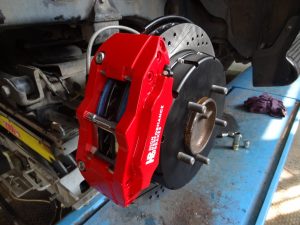Your vehicle’s braking system is one of the most vital components for safety and control. Any failure in this system can lead to dangerous driving situations or even total loss of vehicle control. Fortunately, most brake system issues show early warning signs — if you know what to look for. In this article, we’ll discuss the most common brake system failures and how to identify them before they become serious.
Why Brake System Maintenance Matters

A properly functioning brake system ensures:
-
Shorter stopping distances
-
Consistent braking performance
-
Safety for you and others on the road
-
Less wear on other components like tires and suspension
Ignoring early warning signs can lead to costly repairs and increased risk of accidents. That’s why early diagnosis and preventive maintenance are essential.
Most Common Brake System Failures
Below is a table summarizing the most frequent brake-related issues and their common causes:
| Failure Type | Common Causes | Potential Consequences |
|---|---|---|
| Worn Brake Pads | High mileage, aggressive driving | Reduced braking efficiency, rotor damage |
| Leaking Brake Fluid | Damaged brake lines, worn seals | Brake pedal becomes soft or unresponsive |
| Warped Brake Rotors | Overheating, sudden braking under load | Vibrations during braking, reduced control |
| Faulty Brake Calipers | Rust, sticking pistons | Uneven braking, pulling to one side |
| Air in Brake Lines | Improper bleeding, fluid leaks | Spongy brake pedal, poor braking response |
| ABS Malfunction | Sensor failure, wiring issues | Loss of anti-lock functionality |
| Brake Light Warning | Low fluid, worn pads, sensor error | Warning may go unnoticed, leading to failure |
Warning Signs You Should Never Ignore
If you notice any of the symptoms below, it’s time for an immediate brake inspection.
1. Squealing or Grinding Noises
-
Likely Cause: Worn brake pads or metal-on-metal contact.
-
Action: Replace brake pads and inspect rotors.
2. Soft or Spongy Brake Pedal
-
Likely Cause: Air in brake lines or fluid leak.
-
Action: Check for leaks, bleed the brake system.
3. Vehicle Pulls to One Side While Braking
-
Likely Cause: Uneven pad wear or sticking caliper.
-
Action: Inspect and clean calipers, check brake pads.
4. Vibrations During Braking
-
Likely Cause: Warped rotors or uneven pad contact.
-
Action: Resurface or replace rotors.
5. Brake Warning Light On
-
Likely Cause: Low brake fluid or worn-out pads.
-
Action: Check fluid levels and inspect sensor readings.
6. Burning Smell After Braking
-
Likely Cause: Overheated brakes or stuck caliper.
-
Action: Allow brakes to cool, inspect calipers and pads.
Diagnosing Brake System Issues: A Step-by-Step Guide

Here’s how you can perform a basic brake system inspection at home:
Step 1: Visual Inspection
-
Check the brake pad thickness through the wheel spokes.
-
Look for signs of fluid leaks under the car.
-
Inspect the brake rotors for grooves or discoloration.
Step 2: Test the Brake Pedal
-
With the engine off, press the brake pedal. It should feel firm and not sink to the floor.
Step 3: Check Brake Fluid Level
-
Open the brake fluid reservoir and ensure the level is between the “MIN” and “MAX” marks.
-
Fluid should be light in color; dark fluid may indicate contamination.
Step 4: Listen While Driving
-
Drive at low speed and gently apply brakes. Listen for any squealing, grinding, or clicking sounds.
Table: Brake System Maintenance Schedule
| Component | Check/Service Interval | Recommended Action |
|---|---|---|
| Brake Pads | Every 10,000–15,000 km | Replace when thickness <3 mm |
| Brake Fluid | Every 1–2 years | Flush and replace to prevent moisture buildup |
| Rotors | Every 20,000–30,000 km | Resurface or replace if warped or damaged |
| Calipers | Every 30,000 km | Clean, lubricate pins, check for seizing |
| Brake Lines | Annually | Inspect for cracks, corrosion, and leaks |
| ABS System | As needed | Run diagnostics if warning light is on |
Preventive Tips for Longer Brake Life
To reduce the risk of brake failure and extend component lifespan:
-
Avoid harsh braking unless necessary.
-
Use engine braking on downhill slopes.
-
Replace brake fluid regularly to prevent internal corrosion.
-
Keep your wheels and undercarriage clean to prevent rust buildup on calipers and lines.
-
Don’t ignore minor symptoms — early intervention saves money and ensures safety.
When to Replace vs. Repair
| Situation | Recommended Action |
|---|---|
| Brake pads below 3 mm | Replace pads |
| Rotor surface uneven or cracked | Replace or resurface |
| Fluid dark or contaminated | Flush and replace fluid |
| ABS warning light illuminated | Run diagnostic and repair |
| Multiple components showing wear | Full brake system service |
Final Thoughts
Brake failures often begin with subtle symptoms that many drivers overlook. By learning to recognize these early warning signs and performing routine inspections, you can ensure your brake system functions effectively and safely. Don’t wait for total failure — prevention is the best form of protection.
If you’re looking for quality brake parts for your vehicle, be sure to Buy Brake System online for trusted products, fast delivery, and expert support.